Principles of Natural Resource Management at EcoPreserve 2012
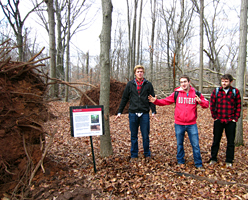 Throughout the Fall 2012 semester, students in Dr. Richard Lathrop's Principles of Natural Resource Management class were hard at work in the Ecological Preserve on Livingston Campus. Known to many students only as the forest for the Gen Bio 101 walking tour, the Ecological Preserve (and Natural Teaching Area) was actually set aside for use as an outdoor classroom, where students can learn about ecosystems, natural processes, flora and fauna. Dr. Lathrop has taken full advantage of this unique platform to give his students some hands-on experience in natural resources management. Students were invited to experiment with the 400-acre tract of mature forest, streams, and meadows. Students worked together in groups and proposed ideas for projects. Examining ecosystem services and using management methods to improve them were fundamental themes for the course.
Throughout the Fall 2012 semester, students in Dr. Richard Lathrop's Principles of Natural Resource Management class were hard at work in the Ecological Preserve on Livingston Campus. Known to many students only as the forest for the Gen Bio 101 walking tour, the Ecological Preserve (and Natural Teaching Area) was actually set aside for use as an outdoor classroom, where students can learn about ecosystems, natural processes, flora and fauna. Dr. Lathrop has taken full advantage of this unique platform to give his students some hands-on experience in natural resources management. Students were invited to experiment with the 400-acre tract of mature forest, streams, and meadows. Students worked together in groups and proposed ideas for projects. Examining ecosystem services and using management methods to improve them were fundamental themes for the course.
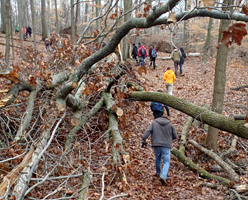 With Hurricane Sandy barreling in mid-semester, students were presented with a unique opportunity to examine the storm's impact on trees in the Kilmer Woods section of the preserve. Chris Licitra, Tim Farrell, and Alex Kaufman (above) took DBH measurements of 130 downed trees and analyzed their locations using GIS software. They found that the most commonly felled trees were older, larger red oaks. They detected a clustered pattern in the tree falls, suggesting the falling trees had a 'domino effect.' These casualties represent habitat loss to birds and other wildlife that prefer large old trees; however, the treefall gaps admit sunlight through the canopy, facilitating the growth of native understory plants - that is, if invasive plants and deer do not get to them first.
With Hurricane Sandy barreling in mid-semester, students were presented with a unique opportunity to examine the storm's impact on trees in the Kilmer Woods section of the preserve. Chris Licitra, Tim Farrell, and Alex Kaufman (above) took DBH measurements of 130 downed trees and analyzed their locations using GIS software. They found that the most commonly felled trees were older, larger red oaks. They detected a clustered pattern in the tree falls, suggesting the falling trees had a 'domino effect.' These casualties represent habitat loss to birds and other wildlife that prefer large old trees; however, the treefall gaps admit sunlight through the canopy, facilitating the growth of native understory plants - that is, if invasive plants and deer do not get to them first.
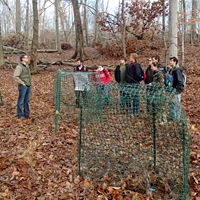 Both the invasive plants and deer overpopulation problems were topics of other projects. Chris Smith experimented with a variety of herbicides on invasive amur honeysuckle, barberry, multiflora rose, and privet, while Nick Murray and Mark Delendra stripped off circumferences of bark (a method called girdling) to kill invasive ailanthus (tree of heaven). Joe Todd, Chloe Lewis and Hyung Kim set up a fenced deer exclosure to examine the effects of deer browsing on understory plants and tree regeneration in a gap created by Sandy. Emily Fishbach and Tyler Hardy planted native shrubs to try to jumpstart a native shrub layer in an upland gap, while Patrice Crocevera, Jennifer Crumley and Hoan Kichen worked to restore a riparian buffer zone. The plants were fenced to protect them from intense browsing by deer. To estimate how many deer occupy the preserve, Liz Banyar, Rebecca Hanson, Chase Groninger and Chris Wilkinson conducted a spotlighting survey for deer, driving the periphery of the preserve and walking its trails for four nights. After running their data through population analysis software, they concluded that the preserve, about 1/2 square mile in area, was likely home to approximately 50 deer, much more than their carrying capacity should allow. Their results contributed to the administrative decision for a deer management program to be carried out over this winter.
Both the invasive plants and deer overpopulation problems were topics of other projects. Chris Smith experimented with a variety of herbicides on invasive amur honeysuckle, barberry, multiflora rose, and privet, while Nick Murray and Mark Delendra stripped off circumferences of bark (a method called girdling) to kill invasive ailanthus (tree of heaven). Joe Todd, Chloe Lewis and Hyung Kim set up a fenced deer exclosure to examine the effects of deer browsing on understory plants and tree regeneration in a gap created by Sandy. Emily Fishbach and Tyler Hardy planted native shrubs to try to jumpstart a native shrub layer in an upland gap, while Patrice Crocevera, Jennifer Crumley and Hoan Kichen worked to restore a riparian buffer zone. The plants were fenced to protect them from intense browsing by deer. To estimate how many deer occupy the preserve, Liz Banyar, Rebecca Hanson, Chase Groninger and Chris Wilkinson conducted a spotlighting survey for deer, driving the periphery of the preserve and walking its trails for four nights. After running their data through population analysis software, they concluded that the preserve, about 1/2 square mile in area, was likely home to approximately 50 deer, much more than their carrying capacity should allow. Their results contributed to the administrative decision for a deer management program to be carried out over this winter.
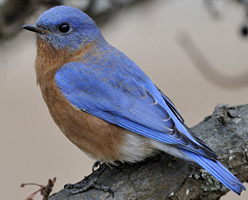 Several wooden nest boxes have cropped up in a meadow portion of the preserve. Smaller homes on short posts are designed for Eastern Bluebirds, while Eastern Screech Owls may select from among four larger boxes on 20 foot vantages. Both species rely upon cavities in wood for nesting, which have become more limited due to fewer dead standing trees in our modern landscape and greater competition for cavities by non-native birds such as House Sparrows and Starlings. Eastern bluebirds are popular among birdwatchers for their vivid plumage. The nest boxes that Liz Ostrowski and Bronwyn Harris built for them were designed to discourage squirrels and house sparrows. Both the bluebird and owl boxes were positioned to face southeast, to optimize warmth by facing away from prevailing winds. One of the owl boxes is almost sure to host an occupant next spring, as students Kevin Corrigan, Patrick Lepore and Max Thomas, along with members of the Raptor Trust wild bird rehabilitation center in Millington, NJ, have arranged for the release of a rescued screech owl in the preserve this spring.
Several wooden nest boxes have cropped up in a meadow portion of the preserve. Smaller homes on short posts are designed for Eastern Bluebirds, while Eastern Screech Owls may select from among four larger boxes on 20 foot vantages. Both species rely upon cavities in wood for nesting, which have become more limited due to fewer dead standing trees in our modern landscape and greater competition for cavities by non-native birds such as House Sparrows and Starlings. Eastern bluebirds are popular among birdwatchers for their vivid plumage. The nest boxes that Liz Ostrowski and Bronwyn Harris built for them were designed to discourage squirrels and house sparrows. Both the bluebird and owl boxes were positioned to face southeast, to optimize warmth by facing away from prevailing winds. One of the owl boxes is almost sure to host an occupant next spring, as students Kevin Corrigan, Patrick Lepore and Max Thomas, along with members of the Raptor Trust wild bird rehabilitation center in Millington, NJ, have arranged for the release of a rescued screech owl in the preserve this spring.
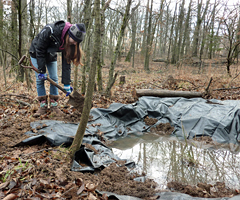 Students are working to restore other habitats in the preserve. Scott Busby, Kyle Oschell and Conor Fitzgerald added large woody debris and rock formations to slow down bank erosion in a tributary of Buell Brook. Samm Wehman and Amanda Shortell (left) excavated and modified vernal pools that they hope will attract amphibians such as spring peepers or American toads come spring. If successful, they may try to introduce vernal pool obligate amphibians, like the wood frog. Where Samm and Amanda are adding water habitats to the landscape, Chelcey Nodstrom, Mike Ciappi and Oliver Stringham are looking to restore the remnant meadows with fire. Prescribed burning is a management tool for eradicating invasive plants and allowing the growth of new plant life, which promotes biodiversity and a healthy ecosystem. It also reduces an area's potential for wildfire by removing fuel load, as in a dry field. The controlled burning will be carried out by a professional from the NJ Fire Service.
Students are working to restore other habitats in the preserve. Scott Busby, Kyle Oschell and Conor Fitzgerald added large woody debris and rock formations to slow down bank erosion in a tributary of Buell Brook. Samm Wehman and Amanda Shortell (left) excavated and modified vernal pools that they hope will attract amphibians such as spring peepers or American toads come spring. If successful, they may try to introduce vernal pool obligate amphibians, like the wood frog. Where Samm and Amanda are adding water habitats to the landscape, Chelcey Nodstrom, Mike Ciappi and Oliver Stringham are looking to restore the remnant meadows with fire. Prescribed burning is a management tool for eradicating invasive plants and allowing the growth of new plant life, which promotes biodiversity and a healthy ecosystem. It also reduces an area's potential for wildfire by removing fuel load, as in a dry field. The controlled burning will be carried out by a professional from the NJ Fire Service.
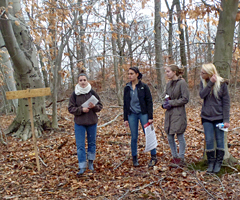 To help communicate an ecological message to the broader Rutgers population, Domique Dionne, Marta Bravo, Eliana Geretz, and Marisa Palestino (pictured right) created a series of informative posted along the tour route taken by dozens of General Biology students every spring. The students also created a virtual on-line tour.
To help communicate an ecological message to the broader Rutgers population, Domique Dionne, Marta Bravo, Eliana Geretz, and Marisa Palestino (pictured right) created a series of informative posted along the tour route taken by dozens of General Biology students every spring. The students also created a virtual on-line tour.
This is the second semester of Principles of Natural Resource Management since its creation in fall 2011. The class doubled in size this year due to a high demand for hands-on experience. Lathrop describes his take on how environmental education can be taught: "The full name of the EcoPreserve is the Ecological Preserve and Natural Teaching Area. So in the spirit of a Natural Teaching Area, I see the EcoPreserve as a working laboratory where classes can try out ideas and see where they lead. My goal is to move beyond the 'passive' nature tour mode of instruction to promote full body and mind engagement in the natural world. By doing 'real' restoration and management projects, students are investing their blood, sweat, and blisters in the EcoPreserve, and it's my hope that they will go back there in the spring and even 5 years hence to see the fruits of their labor."
Story Contributed by Karen Leu and edited by Richard Lathrop.


